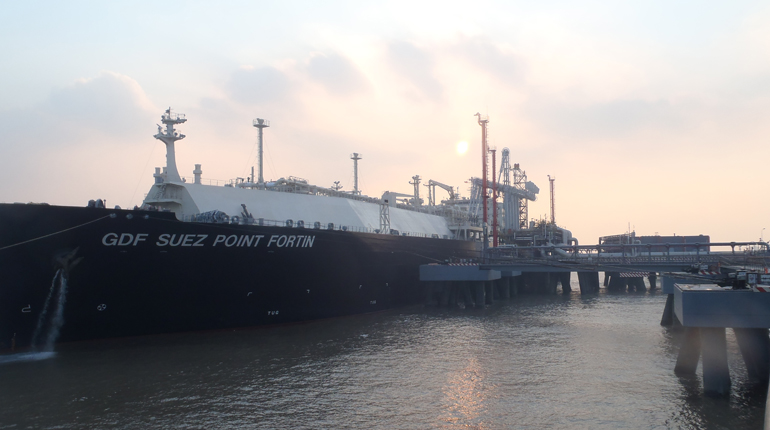 PetroChina’s Caofeidian LNG terminal. The IEA says the country’s demand for gas is hard to predict. (Engie)
PetroChina’s Caofeidian LNG terminal. The IEA says the country’s demand for gas is hard to predict. (Engie)
Global gas demand is expected to increase by 1.5%, equating to 340 billion cubic metres per year, over the next five years. However, a blurry outlook for China makes any form of prediction more challenging, the International Energy Agency (IEA) said on Wednesday.
In its Medium-Term Gas Market Report, the IEA described China as "the biggest demand-side risk to the forecast". The organisation forecasts global gas demand will reach 3.9 trillion cubic metres in 2021, after demand returned to growth in 2015. The 1.5% annual growth rate predicted over the next five years is a slight drop compared with the 2% predicted last year.
While the picture in China is uncertain, the IEA predicted strong gas demand growth in India, an annual rate of 6% until 2021, underpinned by stabilising domestic production and cheaper LNG imports.
Marco Giuli, an energy analyst with the Brussels-based European Policy Centre, told Interfax Natural Gas Daily he agreed that predicting the outlook for China was particularly challenging.
"The outlook for China is much more uncertain than for India. China is beginning to decouple economic growth from primary energy demand and is taking its environmental obligations quite seriously. What we see is a huge build-up of renewable energy but not so much a build-up of new [combined-cycle gas turbines]," said Giuli.
China also seems keen to become more independent from energy imports because of geopolitical risks, said Giuli. "In my view, China’s preference will be to develop domestic energy resources such as shale gas and renewables rather than importing energy. China does not import a lot of LNG, but what it imports is mostly from Australia, and it sees the South China Sea as an increasingly dangerous place due to territorial disputes with Vietnam and the Philippines," he added.
Uncertain outlook
Marc Hedin, an associate with Aurora Energy Research, agreed there were "huge uncertainties" over the outlook for Chinese gas demand. However increasing levels of coal-to-gas switching in China could make a significant impact on world markets, he said.
"Gas demand in China is essentially driven by GDP growth and coal-to-gas switching in electricity generation," Hedin said. "With around three-quarters of power generation in China from coal at the moment, even a small switch on the coal side would result in enormous additional gas demand in China, which could have a huge impact on global markets. There is no way China could be self-sufficient in gas supply, and a lot of the imports would have to be LNG."
On the global supply side, new LNG export projects in Australia, Qatar and the United States will add substantial volumes despite weakening demand in Japan and South Korea, the IEA said. It predicted that liquefaction capacity will increase by 45% between 2015 and 2021, mostly from the US and Australia. The additional LNG volumes will look for a home in Europe because of the flexibility of its gas system and its well-developed spot markets, the IEA said.
"Massive quantities of LNG exports [are]coming online while [...] demand continues to soften in traditional markets," said the IEA’s Executive Director Fatih Birol. "These contradictory trends will both impact trade and keep spot gas prices under pressure."
However, some are less convinced by the sheer volume of liquefaction capacity set to come online.
"The LNG export projects in the US and Australia are high-cost projects, of which most will only be economically viable when capital is cheap and interest rates are at zero," Arash Duero, an energy specialist at Pflüger International, told Interfax Natural Gas Daily. "I think there is a chance the US Federal Reserve will raise interest rates once a new US president takes office. This heightens the risk of many US projects being cancelled as many of them have taken on huge amounts of debt. The same goes for projects in Australia."
Others said new LNG export projects would add volumes to an already oversupplied market – even if some are cancelled.
"Even if we see some projects cancelled, there is still a huge amount of new liquefaction capacity coming online, particularly in the US and Australia. The global gas market is already oversupplied and it could take years to return to equilibrium. It may in fact take up to 10 years for the LNG market to rebalance," Hedin said.
The IEA predicted European gas demand would stabilise over the next five years as retiring nuclear and coal capacity in the power sector would offer some relief for gas-fired power generation.
However, it played down the impact of energy efficiency as the refurbishment of Europe’s ageing building stock remains slow. Brussels sees energy efficiency as a key tool to reduce the EU’s growing dependence on imported fossil fuels. The 28 member states have agreed on a 27% energy efficiency target by 2030, However, many say this target is not ambitious enough.
"On the demand side, the buildings sector is a much more important gas consumer than the electricity sector. To this end, the EU’s 2030 energy efficiency targets are not very ambitious. They may be reviewed, but new targets would require unanimous backing from the Council of the EU, which is not easily achieved," said Giuli.








Talk to us
Natural Gas Daily welcomes your comments. Email us at [email protected].